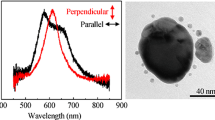Abstract
The intermonomer interaction effect on electromagnetically induced transparency (EIT) in dipole-coupled dimer models with different orientations and intermonomer distances is investigated. The absorption properties are evaluated using the imaginary part of the dynamic polarizability α calculated by the quantum master equation method. It is found that EIT can be observed even in the dimer systems with near-degenerate excited states originating in an intermonomer interaction by adjusting the incident field frequency.
Access this chapter
Tax calculation will be finalised at checkout
Purchases are for personal use only
Similar content being viewed by others
References
Fleischhauer M, Imamoğlu A, Marangos JP (2005) Rev Mod Phys 77:633–673
Boyd RW (2008) Nonlinear optics, 3rd edn. Elsevier, New York
Harris SE, Field JE, Imamoğlu A (1990) Phys Rev Lett 64:1107–1110
Field JE, Han KH, Harris SE (1991) Phys Rev Lett 67:3062–3065
Bolloer KJ, Imamoğlu A, Harris SE (1991) Phys Rev Lett 66:2593–2596
Ham BS, Hemmer PR, Shahriar MS (1997) Opt Comm 144:227–230
Marcinkevičius S, Gushterov A, Reithmaier JP (2008) Appl Phys Lett 92(041113):1–3
Xu H, Lu Y, Lee Y, Ham BS (2009) Opt Express 18:17736–17747
Light PS, Benabid F, Pearce GJ, Couny F, Bird DM (2009) Appl Phys Lett 94:141103-1-3
Schmidt H, Imamoğlu A (1996) Opt Lett 21:1936–1938
Hau LV, Harris SE, Dutton Z, Behroozi CH (1999) Nature 397:594–598
Harris SE, Hau LV (1999) Phys Rev Lett 82:4611–4614
Liu C, Dutton Z, Behroozi CH, Hau LV (2001) Nature 409:490–493
Mücke M, Figueroa E, Bochmann J, Hahn C, Murr K, Ritter S, Villas-Boas CJ, Rempe G (2010) Nature 465:755–758
Gea-Banacloche J, Mumba M, **ao M (2006) Phys Rev 74:165330-1-7
Nakano M, Yamaguchi K (1995) Chem Phys Lett 234:323–329
Takahata M, Nakano M, Fujita H, Yamaguchi K (2002) Chem Phys Lett 363:422–428
Leegwater JA, Durrant JR, Klung DR (1997) J Phys Chem B 101:7205–7210
Nakano M, Takahata M, Fujita H, Kiribayashi S, Yamaguchi K (2000) Chem Phys Lett 323:249–256
Shuai Z, Brédas JL (1991) Phys Rev B 44:5962–5965
Nakano M, Yamaguchi K (1994) Phys Rev A 50:2989–3004
Takahata M, Nakano M, Yamada S, Yamaguchi K (2003) Int J Quant Chem 95:472–478
Acknowledgments
This work is supported by a Grant-in-Aid for Scientific Research (No. 21350011) from Japan Society for the Promotion of Science (JSPS) and the global COE (center of excellence) program “Global Education and Research Center for Bio-Environmental Chemistry” of Osaka University. Tayuka Minami expresses his special thanks for a JSPS Research Fellowship for Young Scientists (No. 1221350011).
Author information
Authors and Affiliations
Corresponding author
Editor information
Editors and Affiliations
Rights and permissions
Copyright information
© 2012 Springer Science+Business Media Dordrecht
About this paper
Cite this paper
Minami, T., Nakano, M. (2012). Quantum Master Equation Study of Electromagnetically Induced Transparency in Dipole-Coupled Dimer Models. In: Nishikawa, K., Maruani, J., Brändas, E., Delgado-Barrio, G., Piecuch, P. (eds) Quantum Systems in Chemistry and Physics. Progress in Theoretical Chemistry and Physics, vol 26. Springer, Dordrecht. https://doi.org/10.1007/978-94-007-5297-9_5
Download citation
DOI: https://doi.org/10.1007/978-94-007-5297-9_5
Published:
Publisher Name: Springer, Dordrecht
Print ISBN: 978-94-007-5296-2
Online ISBN: 978-94-007-5297-9
eBook Packages: Chemistry and Materials ScienceChemistry and Material Science (R0)



